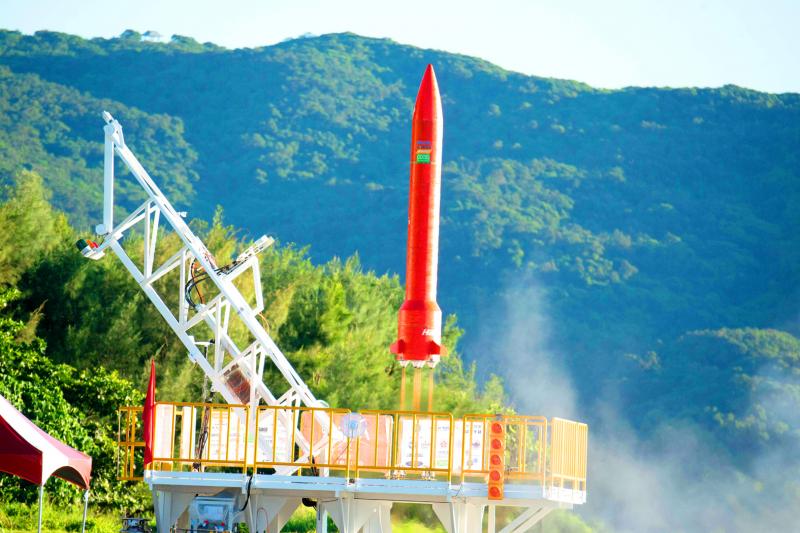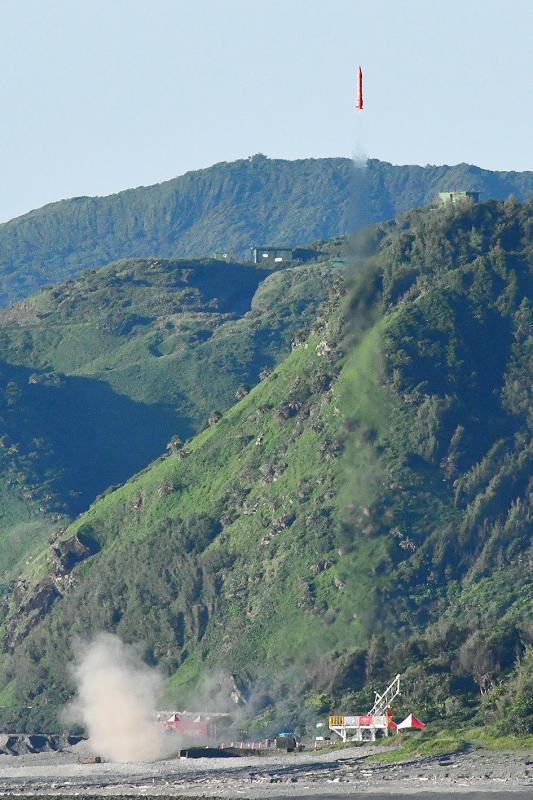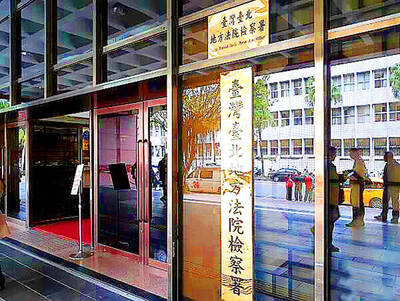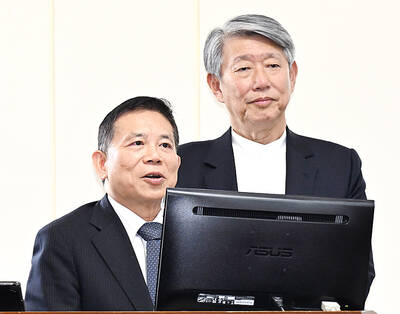Researchers from National Yang Ming Chiao Tung University’s Advanced Rocket Research Center (ARRC) yesterday successfully tested the second-stage propulsion system of a domestically designed rocket.
Minister of Science and Technology Wu Cheng-chung (吳政忠) lauded the test of the HTTP-3A sounding rocket’s propulsion system, saying it demonstrated the integration of industry and academia in Taiwan at a time when the global space industry is developing.
The test, which was originally scheduled for May 3, began at 6:12am yesterday, with the rocket launching from Syuhai Village (旭海) in Pingtung County’s Mudan Township (牡丹).

Photo provided by the National Space Center
According to the initial flight plan, the 4.8m, 365kg rocket was to lift off vertically for five seconds before arcing out over the sea, when its engine would shut off after 60 seconds and a drogue parachute would deploy after 90 seconds.
Then, after reaching a lower altitude, it would release a second parachute and land in the sea, having reached an altitude of 12km during an eight to 10-minute flight.
Yesterday’s launch fell short in that regard, as the rocket stayed in the air for two minutes and reached a maximum altitude of about 3km, but it was nevertheless “99 percent successful,” the ARRC said.

Photo: Tsai Tsung-hsien, Taipei Times
The launch tested the rocket’s hybrid propulsion system — which uses a mix of liquid and solid-state propellants — navigation system, ground controls, recovery parachute and launch preparations, it added.
The hybrid-fuel sounding rocket does not need navigation assistance to guide its flight, ARRC director Wei Shih-hsin (魏世昕) said, adding that after vertical takeoff the rocket can adjust its flight path, thrust magnitude and thrust vector by itself.
“The HTTP-3A is the world’s first hybrid rocket with guidance and control technology. Although it is not capable of flying very high, it represents a major technological breakthrough,” he said.
The launch allowed the team to test its self-developed, six degrees of freedom mission-analysis simulator, called ZIYASim, he said, adding that it was the first successful rocket launch at the launch site.
“It was much hotter than in May when we were first scheduled to launch, making it a harsher work environment, but the team lived up to expectations,” he said. “The team showed that ZIYASim achieves great accuracy, and all of the data we gathered will be used for the next stage as we move toward launching satellites.”
The media’s reporting of the launch since May has focused attention on Taiwan’s domestic space industry, and the Ministry of Science and Technology’s support made it possible to ensure that the launch site and facilities were ready in just one month, he added.
Additional reporting by CNA

INVESTIGATION: The case is the latest instance of a DPP figure being implicated in an espionage network accused of allegedly leaking information to Chinese intelligence Democratic Progressive Party (DPP) member Ho Jen-chieh (何仁傑) was detained and held incommunicado yesterday on suspicion of spying for China during his tenure as assistant to then-minister of foreign affairs Joseph Wu (吳釗燮). The Taipei District Prosecutors’ Office said Ho was implicated during its investigation into alleged spying activities by former Presidential Office consultant Wu Shang-yu (吳尚雨). Prosecutors said there is reason to believe Ho breached the National Security Act (國家安全法) by leaking classified Ministry of Foreign Affairs information to Chinese intelligence. Following interrogation, prosecutors petitioned the Taipei District Court to detain Ho, citing concerns over potential collusion or tampering of evidence. The

NEGOTIATIONS: Taiwan has good relations with Washington and the outlook for the negotiations looks promising, Minister of Economic Affairs J.W. Kuo said Taiwan’s GDP growth this year is expected to decrease by 0.43 to 1.61 percentage points due to the effects of US tariffs, National Development Council (NDC) Minister Paul Liu (劉鏡清) said at a meeting of the legislature’s Economics Committee in Taipei yesterday, citing a preliminary estimate by a private research institution. Taiwan’s economy would be significantly affected by the 32 percent “reciprocal” tariffs slapped by the US, which took effect yesterday, Liu said, adding that GDP growth could fall below 3 percent and potentially even dip below 2 percent to 1.53 percent this year. The council has commissioned another institution

NEGOTIATIONS: The US response to the countermeasures and plans Taiwan presented has been positive, including boosting procurement and investment, the president said Taiwan is included in the first group for trade negotiations with the US, President William Lai (賴清德) said yesterday, as he seeks to shield Taiwanese exporters from a 32 percent tariff. In Washington, US Trade Representative Jamieson Greer said in an interview on Fox News on Thursday that he would speak to his Taiwanese and Israeli counterparts yesterday about tariffs after holding a long discussion with the Vietnamese earlier. US President Donald Trump on Wednesday postponed punishing levies on multiple trade partners, including Taiwan, for three months after trillions of US dollars were wiped off global markets. He has maintained a 10 percent

TRADE: The premier pledged safeguards on ‘Made in Taiwan’ labeling, anti-dumping measures and stricter export controls to strengthen its position in trade talks Products labeled “made in Taiwan” must be genuinely made in Taiwan, Premier Cho Jung-tai (卓榮泰) said yesterday, vowing to enforce strict safeguards against “origin laundering” and initiate anti-dumping investigations to prevent China dumping its products in Taiwan. Cho made the remarks in a discussion session with representatives from industries in Kaohsiung. In response to the US government’s recent announcement of “reciprocal” tariffs on its trading partners, President William Lai (賴清德) and Cho last week began a series of consultations with industry leaders nationwide to gather feedback and address concerns. Taiwanese and US officials held a videoconference on Friday evening to discuss the